The Klamath-Siskiyou Mountains:
A Center of Diversity, Endemism, and Rarity
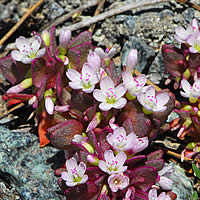
Brandegee's springbeauty (Claytonia saxosa) is a broad endemic that grows on very open, rocky serpentine habitats that have minimal soil. Photo by Steve Conger.
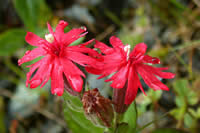
Silene serpentinicola, a rare species, is endemic to the coastal serpentine communities of the Klamath-Siskiyou Mountains. Photo by Norman Jensen, Photo·grafica botanii.
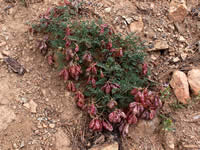
Astragalus whitneyi ssp. siskiyouense is characteristic of dry, rocky serpentines of the Trinity Ultramafic Sheet. Photo by Julie Kierstead Nelson.
The Klamath-Siskiyou Mountains are considered a center of diversity and endemism. Species or species assemblages occur in this geographic area and nowhere else in the world. Much of the area’s diversity is attributed to the extensiveness of serpentine landscapes and the endemic species they support. Explanations for why here and why now are varied.
Endemics are species that are found in one place or region, or associated with particular substrates such as serpentine, limestone, or granitics. Most of the endemics associated with serpentine soils are considered neoendemics, meaning that they are newly evolved on the scene from neighboring non-serpentine ancestors. The serpentine environment can exert strong selective pressures on a species leading to speciation. Geographic isolation also plays a role in speciation as species residing on serpentine islands became reproductively isolated.
The selection pressures of a serpentine environment and the geographic isolation explain some of the high diversity and endemism, but there are some other factors to consider. One of these is time.
What a Difference 5 Million Years Makes
Accretion events in the Klamath-Siskiyou Mountains began about 440 million years ago (Paleocene of the Cenozoic Era). Ultramafic ophiolites were embedded or uplifted into the continental margin. These ophiolites did not see the light of day until the Miocene (24 to 5 million years ago) in the eastern Klamath Mountains. Major tectonic uplift brought the western Klamath Mountains above sea level during the Pleistocene 10 to 2 million years ago.
The potential for species to move onto serpentines of the Klamath-Siskiyou began at least 5 million years ago. The age of exposure and the continuity of intact serpentine landscapes in the Klamath-Siskiyou region are factors contributing to this region’s high diversity and endemism, compared to other serpentine areas in western North America.
The Isolation Factor
Serpentine areas occur as patches or belts on the landscape and are therefore isolated from the nearest neighbor by many miles. Isolation can preclude genetic transfer and limit areas for species to spread. If speciation is relatively rapid on serpentines due to strong selective pressures AND species are isolated, diversity and endemism will follow.
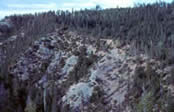
Serpentine barrens surrounded by forest exemplify the patchy distribution of serpentine areas on the landscape. Photo courtesy of Six Rivers National Forest.
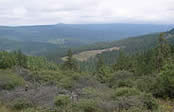
Distant view of serpentine grassland surrounded by Douglas-fir forest. Photo by Richard Helliwell.
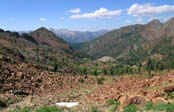
Stark beauty of a serpentine landscape dominated by peridotite; Stonewall Pass, Trinity Alps Wilderness, Shasta-Trinity National Forest. Photo by Shauna Hee.
Think Regional, Act Local
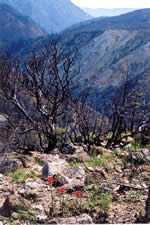
Distant view of the North Fork Smith River watershed after the Biscuit Fire of 2002 showing the highly dissected landscape resulting from past and current tectonic uplift. Photo by John McRae.
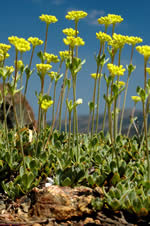
Eriogonum siskiyouense, a high elevation, Klamath-Siskiyou serpentine associate. Photo by Ken DeCamp.
Scientists continue to explore the drivers behind the extraordinary diversity and endemism of serpentines in the Klamath-Siskiyou region. Emerging are factors related to floristic richness and diversity of the region, and thus the potential availability of species to move onto serpentine areas over evolutionary time. Climate and topographic complexity are considered strong influences on regional diversity. This is borne out when we look at the Klamath-Siskiyou Region.
In general, plant species diversity in California is correlated to rainfall; endemics follow the same pattern. In the Klamath-Siskiyou region, serpentine rocks nearest the coast are exposed to 78 to 120 inches of precipitation per year. Perhaps this amount of rainfall, ever so slightly increases the productivity of serpentine communities in this region, allowing more environmental latitude for species to survive. Another factor in explaining regional diversity is the highly dissected and heterogeneous topography, the result of plate tectonics-driven uplift and faulting. This heterogeneity yields an array of plant niches.
Diversity factors at a local scale include the variability of serpentine soil chemistry, particularly with respect to the ratio of calcium to magnesium, slope, aspect, frequency of disturbance such as fire, and the richness of the flora in the surrounding area. Age of exposure, geographic and reproductive isolation, regional species richness, high rainfall, topographic diversity, distinctive (and exclusionary) soils, and natural selection combine to give us the diversity and endemism of the Klamath-Siskiyou serpentines.
As defined by Safford et al., 2005 (PDF, 183 KB):
- A strict endemic is defined as a plant with greater than 95% of its occurrences on serpentine environments;
- A broad endemic is defined as a plant with about 85% to 94% of its occurrences on serpentine environments;
- A broad endemic-strong indicator is defined as a plant with 75% to 84% of its occurrences on serpentine environments; and,
- A strong indicator is defined as a plant with 65% to 74% of its occurrences on serpentine environments.
From an earlier treatment by Kruckeberg (1984) and more recently Safford et al. (2005) and Harrison et al. (2006), the following are some findings associated with serpentine diversity, endemism, and rarity:
- Of the 1,742 plants that have been designated rare or endangered in California, 612 are associated with unique substrates and 46% of those are from serpentines.
- Wildflowers in the genera Streptanthus and Eriogonum dominate the list of serpentine endemics in California as a whole.
In the Klamath-Siskiyou region, however, the genera with the most endemic taxa are Eriogonum (7), Phacelia (4), Minuartia (3), Erythronium (3), Erigeron (3), Epilobium (3). Streptanthus is not as well represented in the Klamath-Siskiyous as it is elsewhere on serpentines in California.
Photo Galleries
Resources and References
- Centres of Plant Diversity: North America: Klamath-Siskiyou Region, California and Oregon, U.S.A.
- Kruckeberg, A. R. 1992. Plant life of western North American ultramafics. Pages: 31-74. in B. A. Roberts and J. Proctor, editors. The ecology of areas with serpentinzed rocks: a world view. Kluwer, Dordrecht, Netherlands.
- Harrison, S., H. D. Safford and J. Wakabayashi. 2004. Does the age of exposure of serpentine explain variation in endemic plant diversity in California? International Geology Review, Vol. 46, pp. 235-242. (PDF, 1.0 MB)
- Harrison, S., H. D. Safford, J. B. Grace, J. H. Viers and K. F. Davies. 2006. Regional and local species richness in an insular environment: serpentine plants in California. Ecological Monographs 76:41–56. (PDF, 222 KB)
- Safford, H. D., J. H. Viers, and S. P. Harrison. 2005. Serpentine Endemism in the California Flora: A Database of Serpentine Affinity. Madrono Vol 52, No. 4 pp. 222-257. (PDF, 183 KB)
Next: From Woodland to Wetland, the Diversity of Serpentine Plant Communities »
|







